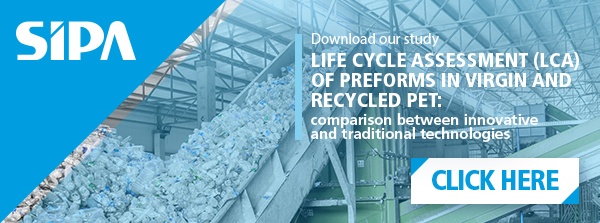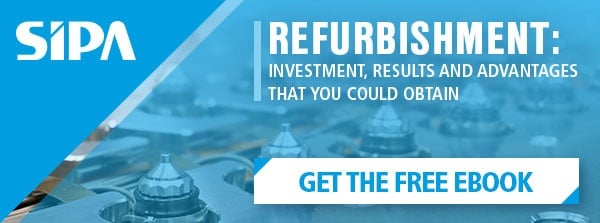Defining a PET Preform
The preform is an article made of Polyethylene Terephthalate, commonly known as PET. It is normally manufactured using a mould on an injection system, which is subsequently blown into a container for edible or non-edible liquids (water, soft drinks, milk, alcohol, oils, detergents, personal care) on a blowmoulding system.
In practice, what comes out of the machine is a test-tube shaped object with a threaded, finished neck that is then transformed into a customised container used to distinguish a specific brand.
The preforms are used both by companies involved in the creation of packaging for third party companies, and by industries that carry out all phases of production in house, from creation of these PET articles to bottling of the end product.
The technical characteristics of the machines and moulds used to create the preforms are very important, as they determine fundamental aspects such as:
- production speed,
- product quality,
- power consumption,
- process costs,
- frequency of maintenance.
Also, given the level of customisation required by companies in the beverages sector, customisation of the preforms to obtain made-to-measure packaging is increasingly of central importance.
TECHNICAL STUDY: "How to select PET preform injection moulds"
PET Design: designing preforms
Design of the preform is a fundamental phase, because a series of factors that characterise the bottle are dependent on this article:
- General quality of the container
- Wall and bottom thickness
- Reduction in weight
- Neck width
- Size and appearance of the thread
A lower bottle thickness has an influence on material savings and, obviously, on making the finished container lighter, but it is always necessary to take into account its strength and the type of shape to be obtained. It is necessary to study the customer’s needs carefully, in order to set up an efficient production process.
TECHNICAL STUDY: "Lightweight bottle. Reducing PET containers weight and the Lifecycle"
Another aspect that must not be underestimated is design of the bottle neck. This element can also be made lighter and customised, further optimising the quality and characteristics of the container.
Finally, those responsible for designing the preform must be able to satisfy even customers who need special containers, for example large size, stackable, with asymmetric shapes, suitable for hot liquids.
To obtain containers with such specific technical characteristics the role of the preform designer is of fundamental importance.
Regulations on plastic reduction in the US and Japan
The PET lightweight process developed in parallel with the need not to affect the performance of the final product, since companies shall maintain specific properties of resistance, impermeability and stability of the bottles.
Actually, this is a process started already since the early years of this decade; the average weight of a half-liter PET bottle had already decreased by almost 50%, giving way to lightweighting.
PET Lightweight: environmental protection and savings
Lightening the weight of containers is a trend in the sector that must be followed in order to remain competitive on the market.
This does not mean giving up the quality of the PET bottles, on the contrary, thanks to increasingly advanced technology, the strength of the packaging is guaranteed even when the thickness is less.
TECHNICAL STUDY: "PET lightweighting: how to safeguard the strength of bottles"
Companies in the food sector are increasingly turning towards eco-sustainable practices and, as a result, they are looking for bottling solutions with a lower environmental impact. PET lightening is certainly a considerable step forwards in this regard, and also gives advantages for companies in terms of lower costs and increased earnings.
Switching to lighter, smaller packaging means using less PET and this gives a saving in materials, obviously, but also a saving in harmful emissions due to a reduction in the number of transport vehicles in circulation and less voluminous finished products.
Less use of raw materials and more streamlined logistics are elements that also result in lower expenses, bringing a boost to the company budget.
This new approach, which is of benefit to companies in the Food & Beverage sector and to all those using PET packaging, would be ineffective if it does not produce containers with characteristics that will satisfy consumers.
As early as the preform design phase it is necessary to take into account the elements that will make the PET container suitable for the company that will be using it.
A thinner, lighter bottle must:
- Protect the contents
- Give a saving in resources during production
- Optimise storage and transport
- Give positive sensations for consumers (appearance, consistency, safety)
- Have the lowest possible impact on the environment
Combining ecological sensitivity with the efficiency of industrial processes is what makes the difference today. It is necessary to market products that show customers the company’s commitment to safeguarding the climate, while still maintaining quality and communication standards.
Packaging is one of the main protagonists in all these points and, therefore, the production of PET preforms must be carried out using technologies that guarantee advantages both for companies and for the end consumers of food and beverages.
Economic benefits: here are some examples
As well as the advantages for the eco-system already mentioned, it is necessary to stress the economic benefits deriving from new technology applied to the production of PET preforms.
The main factors that cause cost savings and increased gains are:
- Lower preform weight
- Lower energy required
- Less maintenance
- Less manpower
- Greater production
To get a better understanding of how lightening of preforms can result in advantages for companies, we give several examples, already dealt with in the article “PET lightweighting: how to safeguard the strength of bottles”, which relate to three international brands: San Pellegrino, Coca-Cola, Nokia.
By lightweighting its bottles, San Pellegrino has achieved a saving of approximately 850,000 pounds of PET per year and Coca-Cola Company has saved 650 tons. The need for less material and optimisation of transport has also meant that the two companies have retained large sums of money in their accounts.
Nokia, on the other hand, has reduced the packaging on its products, halving the use of PET and resulting in 5,000 less trucks a year on the roads.
This has transformed into advantages for the environment and for the accounts of the company, which has earned hundreds of million Euros thanks to this operation.
Need more information? You can learn more about SIPA solutions for PET bottles lightwighting.
Mould refurbishment and inspection
Moulds for the production of preforms cannot be used an infinite number of times, but by making use of refurbishment services it is possible to regenerate these essential elements, thus extending their working life.
Mould refurbishment also enables an increase in the quality of products and the speed with which they are manufactured. Furthermore, this procedure makes the moulds so efficient that it almost eliminates the need for maintenance of the cold half.
When you add to this a mould inspection service, it is possible to achieve extreme efficiency in the production of preforms.
Always remember that poor quality manufacturing causes considerable losses in turnover. Here are some examples:
- Loss of 1 cavity due to the low quality of the preform → monthly cost 690 Euro (equivalent to 8,200 Euro per year)
- Weight of preform 0.1 g too high → monthly cost 2,620 Euro (equivalent to 31,500 Euro per year)
- Increase in cycle time 0.3 s → monthly cost 1,900 Euro (equivalent to 23,000 Euro per year)
Based on: 96 cavity mould working at 10 seconds and with 95% efficiency: Production of preforms with a weight of 11 grams; 8,000 hours production/year; Added value of 0.003 Euro/preform; Cost of resin: 1.2 Euro/Kg.
These figures give an idea of how important machine assistance services also are for PET preform production.
State-of-the-art technology to increase efficiency
In order to have an efficient production of preforms it is necessary to rely on a partner who invests in research and development to provide innovative and flexible solutions both for machinery and for moulds.
In a manufacturing process the technologies that can make a difference, for example, are those optimising the injection unit, the press unit and the moulds.
The injection unit must have characteristics such as a servo drive, continual rotation of the screw at low speed, the ability to use up to 4% colouring agent without a drop in flow and to produce different extrusion sizes, the injection system with minimum loss of plasticization capacity.
For high performance, the press unit must have a fluid closing profile, guarantee excellent cleaning, long working life and minimum maintenance costs.
The moulds must be designed so that the preforms are of high quality and production is fast, they must have reduced maintenance costs, a wear-proof coating, excellent neck cooling systems.
Also, additional advantages are given by the ability to select moulds with up to 144 cavities that can be adapted to machines produced by the main manufacturers on the market.
Machines with injection-compression system must have elements that make the whole process better and more economical, for example: optimised plasticization screw with continual rotation to reduce consumption and AA levels, ability to use up to 100% rPET without making changes, rotating injection-compression wheel with reduced cavity tonnage that allows less wear in the mould.
Machines with technological characteristics such as the ones listed result in a considerable reduction in TCO, make operator tasks safer and easier, and have a decided influence on the quality of the preform and the working life of the moulds.
Now is the time to assess the factors that make up a reliable partner.
TECHNICAL STUDY: "The advantages of SIPA refurbishment for Mpact in South Africa"
Why pick SIPA?
Over thirty years’ experience in the sector makes SIPA a valuable ally both for those producing preforms and for those dealing with the entire production cycle right down to bottling.
Its wide range of products includes machines, moulds and complete lines that are able to satisfy every need.
SIPA preform production machines are extremely high technology and SIPA product range you also comprise single-stage systems with high and low productivity and two-stage systems with high performance line and rotating blowers.
The company’s catalogue also includes filling machines, product preparation systems, secondary packaging solutions, preform injection moulds with up to 144 cavities, suitable both for SIPA machines and those made by other companies and blowing moulds.
The experts at SIPA are able to provide 360° project management, including bottle design and container prototyping assessed using computerised simulation.
Solutions are created taking into account the specific needs of customers, assessing, for example, the production costs, the space available in plants, the level of flexibility and the energy savings to be achieved.
READ ALSO: "Hot runner mould system & operating costs: alignment and cleaning"
Another strong point that allows SIPA to be close to its customers at all times is its worldwide presence:
- 17 sales branches
- 4 production plants: 2 Italy, 1 Romania, 1 China
- 28 post sales service centres (technical support and supply of spare parts)
- 9 injection mould refurbishing service centres: 1 Italy, 1 China, 1 Japan, 1 Thailand, 1 Mexico, 1 South Africa, 1 Brazil, 2 USA
Ongoing investment in research and development has made it possible to create machines and moulds with a lower environmental impact that use rPET, lighten the weight of PET preforms and containers, use less energy and have a longer working life.
SIPA was the first company in the sector to made plastic bottles from plants and renewable sources.
Our studies and co-operation with companies specialising in plastic recycling technology have resulted in the first machine in the world for the production of food-grade preforms from 100% rPET flakes. Its name is XTREME Renew.


